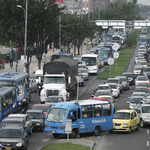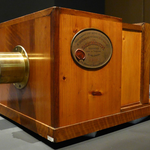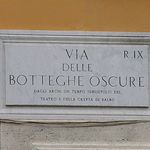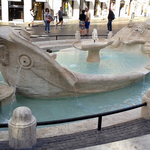Via Appia Antica
It is the "queen of streets" of ancient Rome and one of the oldest and most famous roads of the world. It is certainly the best street for those who wants to feel the taste of the ancient time.
Chariots were passing by here and Roman soldiers were marching to conquer the empire. History made here big steps and last romantics walked here with short steps.
An ancient layout near the Colli Albani was used for its construction and then it had been extended towards Brindisi in various moments. It became the principal linking axis between Rome and Naples, Brindisi and the East. In '500 with the opening of the Via Appia Nuova it was abandoned until the XVII century when it was rediscovered. In 1988 the Archaeological Park of the Via Appia Antica was founded.
On the long strokes the paving was left as if it were in the Roman times. It contains wide and uneven dark stones. Between high cypresses and secular pines there are the ruins of the tombs which existed here when the Appia was the favourite place of Roman patricians who built up their mausoleums here.
There is also an impressive tomb of Cecilia Metella of 50 B.C. Cecilia was known to be a daughter of Metello Cretico and daughter- in- law of Marco Licinio Crasso who in the time of Ceasar was considered to be the richest banker of Rome. In such a very masculine society as the Roman one the reason why such a big and sumptuous mausoleum as emperor's one was dedicated for a woman continues to be a secret of pink chronicles. It was put up in the last few years of the I B.C
and has a diameter of 20 meters. In 1300 the pope Bonifacius VIII presented it to his relatives Caetani who turned it into a stronghold for the control of their property.
But nearby the external monuments kilometers of underground catacombs were arranged. It would be a hypothesis without the basis to presume that it was a refuge for the persecuted Christians or clandestine cult places. However they would probably have served as cemeteries up to the VIth century when they were turned into devotion places.
The tradition instead says that the first persecuted and hunted Christians couldn't find the other refuge place to celebrate their rites and bury their dead than out of the walls in the dark tunnels dug in the land which were presented by some Roman patricians. Being illegitimate the christianity was the new religion and the rich ones baught rewards at a low price. Beginning from the I century A.C. the catacombs always become more numerous, the net of the galleries became wider, loculi (niches for urns) and cunicoli (underground passages) went down at several levels. They looked like small towns turned over. Since the new faith promised that the deceased persons would rise up again the burial with the conservation of a dead person became more than a necessity but a moral duty. "Hic Dormit ", " Here he sleeps" says the engraved graffito found again on the loculus. It was important to say that the deceased person had only appeased waiting for the day of
the Resurrection.
On the 10th of December in 1593 Antonio Bosio called "Columbus of the underground Rome" visited them one by one and recovered the bones and the dressed of martyrs. So good trade of relics began. The "camposantari" had appeared that mean the groups of clandestine researchers including the pilgrims of "patacche".
The catacombs scattered in the subsoil of Rome and numbered 56. The last burial in the catacombs was of a grave-digger buried in 583.
In the Via Appia Antica two following catacombs can be met:
- the catacombs of San Callisto were settled on 4 floors, on an area of 120.000 square meters. The part discovered by nowadays is extended for 20 km of cuniculus. They go up again to 100 D.C. On the walls of the undergrounds escavated in the rock the frescos of the epoch referred to the 100th year B.C. are still well preserved. It's worth seeing the Popes' Crypt in which there are the tombs of 5 pontiffs who reigned from 230 until 283. In the near crypt there is the tomb of Santa Cecilia whose body buried in 303 was found intact after 5 centuries.
The San Sebastiano catacombs are found under the church of San Sebastiano built up in 300 near the cemetery where apostles Peter and Paul had been temporarily buried and where the rests of martyr Sebastian were placed which had been killed by the emperor Dioclition at the blows of arrows.
Some arrows are preserved in the chapel of the relics with the prints of the Jesus feet transported from the Domine Quo Vadis church. The catacombs have 4 floors of tunnels which include: the San Sebastiano crypt with a bust of '600 made by Bernini. The small square under which opens the cavity from which derives the name of a catacomb katàwhich is similar to kymbas that means a cavity. The Triclia, a place where the funeral banquets were kept, the Platonia, once thought
to be the burial place of apostles and today it's considered to be a mausoleum of Quirino. One can also see the chapel of Onorio III with frescos of the XIIIth century.
Almost at the beginning of the street there is a little church of Domine Quo Vadis? (Lord, where do you go ?). It's original name is Santa Maria in Palmis. It already existed in the IXth century and was reconstructed again at the beginning of the XVIIth century by Flaminio Ponzio and Giovanni Venanzio who created the façade and arranged the inside.
According to the tradition popularized by the novel of Sienkiewicz "Quo Vadis" on this site Jesus should have appeared to Saint Peter running away from Rome to avoid the martyrdom. Peter asked him: "Domine Quo Vadis?" The Lord should have answered: "Venio Iterum Crucifigi" (I'm going to crucify myself for the second time). Saint Peter understood it and got back to face the death.

 The records of Rome. Big numbers, not always enviable, for a big city.
The records of Rome. Big numbers, not always enviable, for a big city. New Phot-O-Matic section. To spend some time looking at photos (also) of Rome.
New Phot-O-Matic section. To spend some time looking at photos (also) of Rome. The administrative, urban, toponymic and imaginative subdivisions of Rome.
The administrative, urban, toponymic and imaginative subdivisions of Rome. Notice for tourists: in Rome you drink for free. Historical fountains and 'big noses'.
Notice for tourists: in Rome you drink for free. Historical fountains and 'big noses'. Free museums return on the first Sunday of the month.
Free museums return on the first Sunday of the month.